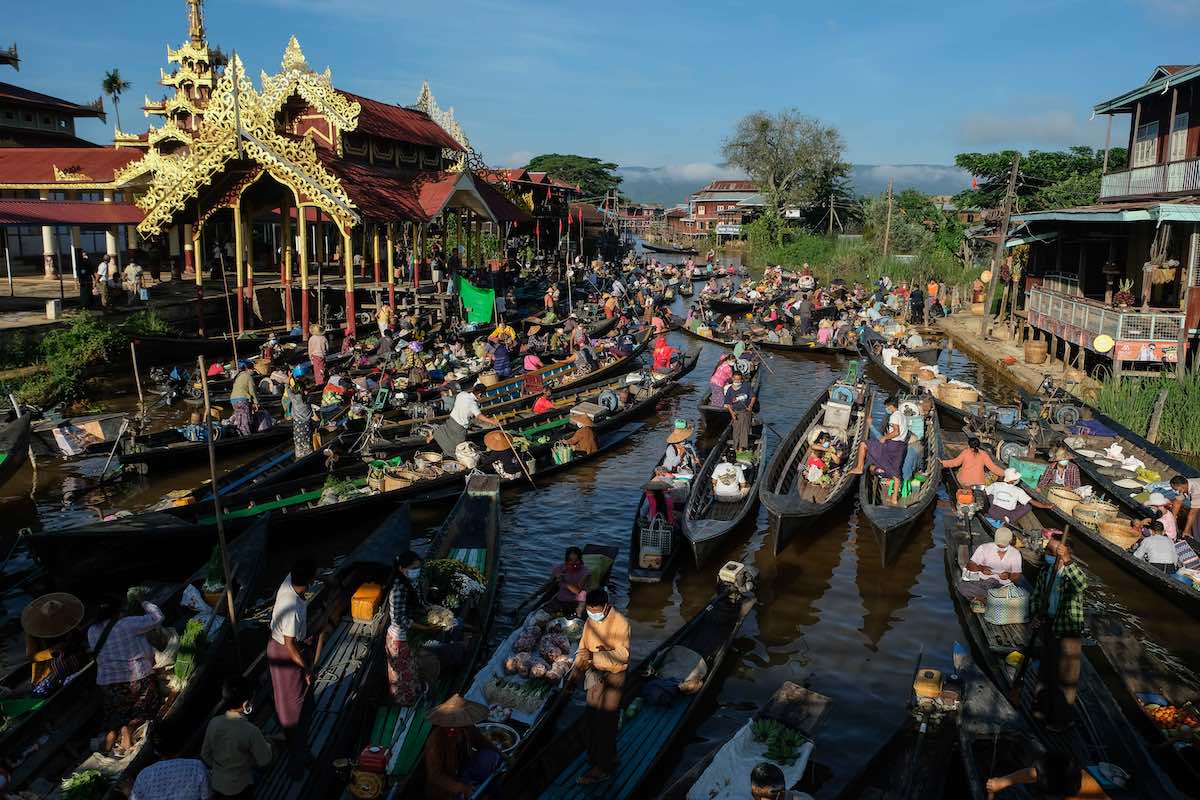 (People buy goods from vendors at a floating market held on boats at Inle Lake in Myanmar's Shan State on October 12, 2020. (Photo: Wai Min Phyoe/AFP via Getty Images))
(People buy goods from vendors at a floating market held on boats at Inle Lake in Myanmar's Shan State on October 12, 2020. (Photo: Wai Min Phyoe/AFP via Getty Images))
She’s a warrior who wears a Filipino-style salakot on her head, sporting a curved sword shaped like an Indonesian Kris, who’s on a journey to restore peace in the dragon-shaped, fantastical world of Kumandra. Who is she? Raya. The titular character of Disney’s newest animated film, “Raya and the Last Dragon,” not to mention Disney’s first Southeast Asian princess (voiced by Vietnamese-American actress Kelly Marie Tran).
While the film’s production team embarked on a journey of their own by venturing across Southeast Asia (SEA) for Kumandra’s inspiration, many expressed disappointment over Disney’s monolithic presentation of this multi-country region, disregarding its diversity in people, language and culture. However, according to producer Osnat Shurer in an interview with The Hollywood Reporter, “the importance of ‘we’ over ‘I,’” allows for a collective celebration of various SEA cultures.
As a Filipino-American, my heart does swell with pride seeing a piece of myself represented in this powerful story of empathy, courage and unity. So, as you watch “Raya and the Last Dragon,” try to notice these dispersed cultural gems that screenwriter Qui Nguyen says to look out for!
Southeast Asian Martial Arts
The film’s antagonist, Naamari, uses Krabi-Krabong (from Thailand). Raya’s fighting style, on the other hand, draws inspiration from a variety of Southeast Asian martial arts: Pencak Silat (from Indonesia), Muay Thai (from Thailand), Võ Thuật (from Vietnam) and Arnis (from the Philippines).
Filipino Martial Arts instructor Alexander Gruezo told YR Media, “Culturally, Arnis is an indigenous art and has been used for thousands of years between warring tribes and eventually invasions by outsiders.”
Raya’s use of Arnis, also known as Kali or Escrima, excited fans when the teaser dropped in October 2020. Throughout the movie, she also wields Arnis’ signature bamboo sticks.
“To have this beautiful art introduced to the world at such a level is something I’ve longed for as an instructor,” Gruezo said. “Many prominent figures such as Lapu-Lapu, warrior chieftain who beheaded [Ferdinand] Magellan, and José Rizal, who was instrumental in gaining Philippines’ independence, knew and practiced Arnis. This is the art of our people.”
Mythical SEA-Inspired Characters
Linguists from the crew’s Southeast Asian Story Trust approved every single name in the story, each having cultural significance.
Raya translates to “celebration” in Malay. It also translates to “one who leads” in Southern Thailand. When creating Raya, screenwriters Qui Nguyen and Adele Lim drew inspiration from female Vietnamese warriors like the Trung sisters. Nguyen also looked to his own mother for inspiration. “I know what she had to go through when she came to this country,” said Nguyen. “It was important for us to show the real spirit of Southeast Asia out there.”
Sisu, voiced by Awkwafina, is a water dragon inspired by the Nāga — a serpent-like creature that is said to lurk in the Mekong River. And how could we forget Tuk Tuk, Raya’s pillbug-pug-armadillo sidekick, who’s named after Cambodia’s brightly colored rickshaws?
Respectful Hand Greetings
Kumandrans greet each other by forming a gem-shape with their hands while lifting it to their foreheads. “That’s a creative take on the common greetings you’ll see in the entire [Southeast Asian] region, where you have clasped hands,” visual anthropologist Steve Arounsack told The Hollywood Reporter.
The higher your hands are, the more respect you show towards others. Different countries refer to the act differently: in Lao, it’s called a nop, but in Thai, it’s called a wai.
Food, Food, Food
Screenwriter Adele Lim said in an interview with Polygon, “[Food] is also our language of love and our language of community.” She’s not kidding!
“Raya and the Last Dragon” features a wide range of Southeast Asian fruits and delicacies: longan, mangosteen, rice, jackfruit, palm sugar, dragonfruit, shrimp paste, Vietnamese bánh tét and durian (the world’s smelliest fruit, but a must try!) among others.
My ears perked up at the too-relatable praise of mango in the film. The Philippine (Carabao) mango, which my family argues is the best in the world, is the country’s national fruit and a dessert staple. I personally love it in ice candy and as an ice cream topper in Halo-Halo, another sweet Filipino classic!
Locations in Kumandra
The film takes viewers through the diverse landscapes of Kumandra’s five regions. We see rice terraces, SEA-style homes and traditional paper lanterns to name a few. The land of Fang and its architecture was actually modeled after many spots from the Disney team’s research trips, including the Angkor Wat temple in Cambodia.
Additionally, floating markets in Laos, Thailand and Indonesia inspired the land of Talon. These markets are known for their boat-riding vendors, the bustling energy, delicious smells and of course, bomb food.

(Photo: Tang Chhin Sothy/AFP via Getty Images)
‘Raya and the Last Dragon,’ is now playing on Disney + Premier Access and in select theaters. You can also discover Kumandra in Disney Animation’s interactive experience!